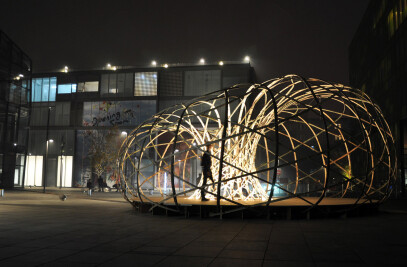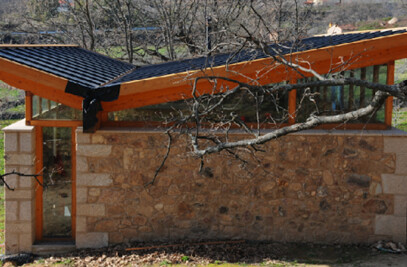The architectural competion for the National Wildflower Centre in Leeds, England, desired an extension to their existing installations, that expressed nature’s mathematical order that is not necessarily immediately apparent in nature, but found upon closer inspection. To test how this building could become an expression of this, Fibonacci series based curves were placed on the site to test the interaction with the available site. From these curves and the site area constraints, the floor plan geometry of the building was derived. A well to collect rainwater was then placed within each of the floor plans. An arch with optimal bearing section was then drawn between the outer curve and the well, and then swept between the two, to create the three dimensional structure of the buildings.
Pragmatically the public and operational areas of the centre are separated into two buildings. Although these two areas are physically distinct from one another, the dialogue between the two forms and paths through the public building invites visitors to view the processes involved in seed production.
It was the explicit desire of the program to work with non-linear surfaces. Natureʼs geometry is an example of how spaces are developed by surfaces growing into spaces. Sections through plants, reveal pockets created single surfaces and the separation of layers into cavities. This same concept was overlayed onto the forms of the buildings, to solve the succession of functions under one single roof.
Secondary skins were added to each building and pulled away from the outer walls as much as necessary to create spaces for functions that require defined areas. In the public building, the remainder of the area has been kept open to allow maximum flexibility of the space with the minimum of intervention. The classroom areas became floating volumes within the overall structure that define spaces of different sizes. By choosing this methodology of defining spaces the flow through both buildings is uninterrupted. This is particularly heightened in the operational building where connections from seed sowing all the way through to dispatch have been created as one single path.
Visitors are invited into this public building through the walled garden. By choosing this entry a strong dialogue is created between the two new buildings and the existing visitors centre and the walled garden of wildflowers. The flow of visitors is then directed out adjacent to the production building where they are invited to walk around the building to learn how seeds are produced, cleaned and packaged.
The building has been devised as a single structure but double clad. This reduces the amount of structural material required for the project whilst ensuring excellent thermal insulation. Each building becomes more opaque to the north where less light intensive functions have been located. The buildings open to the south to allow good solar access. Solar cells would be incorporated into the fabric of the external cladding where appropriate.
































